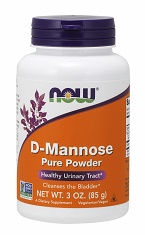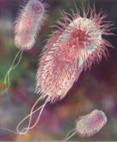Urinary Tract Infection (UTI)

Flush out bacteria by drinking plenty of FLUID every day. Preferably water or unsweetened juices; the ureters and bladder normally prevent urine from backing up toward the kidneys, and the flow of urine from the bladder helps wash bacteria out of the body.
When you urinate, force it out with as much pressure as you can apply. This enables water to work by literally flushing your "pipes".

D-mannose is a simple, white, crystallized sugar, similar to glucose, that occurs in some plants. E.g. cranberries, red currants, gooseberries, other berries, peaches, apples, tomatoes and some vegetables. The D-mannose supplement is derived from the bark of certain trees. Absorbed from the upper intestine 8 times slower than glucose, it has a much lower glycemic index than glucose and does not cause yeast over-growth.
D-Mannose can be used to remove the E. Coli bacteria causing a UTI from the bladder (or other area of the UT). Unless your urine is tested, you don't usually know which type of bacteria is causing the UTI, however, it is estimated that E. Coli is the culprit in 80-90% of UTI cases, so it may be worth just trying it. D-mannose will not work for NON E. Coli infections, so if D-mannose doesn't show significant improvement after about 24 hours, the infection is probably not E. Coli. E.g. Infections caused by Chlamydia, Mycoplasma and N. gonorrhea DO NOT respond to D-mannose treatment, and will need an anti-bacterial treatment.
D-mannose doesn't KILL good or bad bacteria, it just removes them from urinary tract. Compare with mainstream antibiotic treatment which radically changes GI bacterial populations required for good health, D-Mannose removes "bad" bacteria by detaching them from the UT wall and then voiding them in urine. A kind of prebiotic, D-mannose fosters the growth of good bacteria in the GI tract.
D-mannose has no caloric effect and doesn't interfere with blood-sugar regulation even in diabetics. This is because the body metabolizes only small amounts of D-mannose and excretes the rest in the urine. D-mannose is not stored in the liver, and being absorbed from the GI much slower than glucose, has a low gycemic index.
Fortunately, E. Coli's hair-like projections (pili) that stick to the bladder /UT wall stick to d-mannose even better. When a sufficient dose of D-mannose is taken, it spills into the urine, literally "sugar-coating" all the E. Coli's "sticky fingers", including the free-floating E. Coli and those already "stuck" to the UT walls. The E. Coli complex formed is then washed away with the next urination. For more information about how E. Coli operates:
Pathogenic / virilent strains of certain bacteria cause UTIs
In all but 2 of 43 women (av. 47 yrs of age) with an active UTI (acute uncomplicated cystitis) had improved symptoms after taking d-mannose. They took 1.5 grams d-mannose twice daily for 3 days and then once a day for 10 days. After 15 days, cultures were negative for UTI infection in 39 (90.7%) of patients. Pretty impressive! Symptoms showing significant improvement were dysuria (painful urination), frequent voiding, urgency, tenesmus (coninual/recurrent inclination to evacuate the bowel) and suprapubic pain. (DOMENICI, 2016)
- Prophylatic d-Mannose prevented recurrence. One month later the 43 patients were consecutively randomized into two groups: Group 1 (n=22) received prophylaxis of D-mannose one week / month every other month. Group 2 (n = 21) were untreated. of those receiving prophylaxis, only 1 woman (4.5%) had a recurrence within 6 months, whereas recurrences occurred in 7 women (33.3%) in the untreated group. Rate of recurrence in other studies is typically 15 - 53% in a 6 or 12 months period. (DOMENICI, 2016)
Daily dose of 2 g d-mannose was superior to placebo in preventing UTI (Wellens et al, 2008)
D-Mannose shown to inhibit the adherence of intact bacteria to epithelial cells. (Ofek, 1977)
in vitro tests showed that for several E. Coli strains, D-mannose inhibited adherence to uroepithelial cells by 76 to 100%; (Ofek, 1978)
D-mannose powder was associated with a signficant recurrence reduction of bladder infection in women. D-mannose powder was given to 308 women with a history of recurrent bladder infections after the completion of antibiotic treatment. Participants were randomized to D-mannose powder (2 grams in 200 milliliters of water per day) vs a daily oral antibiotic vs no prophylaxis. After 6 months, D-mannose was associated with a significant reduction in recurrent bladder infections when compared to both antibiotic and control groups. Women experienced fewer side effects (nausea, skin rash, headache, vaginal burning) with D-mannose compared to the antibiotic. (Kranjcec, 2014)

Powder is the most economical form. The slightly sweet powder is practically flavorless, but actually tastes good when dissolved in a glass of water or juice. D-mannose is also available as capsules (avoids fillers sometimes added to powders), but you may have to take up to 4 -500mg capsules to obtain required dose.
For treatment of an active UTI:
1.5 grams twice/day for 3 days, and then 1.5 grams once/day daily for 10 days;
Alternatively - take 1 gram three times /day for 14 days
To prevent the return of frequent/chronic UTIs: 2 grams once/day or 1 gram twice/day
Expect the infection to be considerably better within 24 hours, if not, it is probably not being caused by E. Coli. If D-mannose is taking care of the problem, ensure you flush out all E. Coli bacteria by continuing taking it for a few days after symptoms subside, maybe at a slightly reduced dose or less frequently
Supplemental d-mannose powder is readily available for purchase. E.g. ClearTract Powder, NOW Foods D-Mannose powder (85g cost < $20).
D-mannose in food will not clear a UTI. Mannose is one of the easier essential sugars to obtain from our diets, but it does NOT occur in sufficient amounts required to stop a UTI.
ANTHONY J. SCHAEFFER,* SUSAN K. AMUNDSEN, AND LAWRENCE N. SCHMIDT (Jun 1979) Adherence of Escherichia coli to Human Urinary Tract Epithelial Cells, INFECTION AND IMMUNITY: pgs 753-759 Pdf article
L. DOMENICI, M. MONTI, C. BRACCHI, M. GIORGINI, V. COLAGIOVANNI, L. MUZII, P. BENEDETTI PANICI (2016) D-mannose: a promising support for acute urinary tract infections in women. A pilot study. European Review for Medical and Pharmacological Sciences. 20: 2920-2925 Pdf article
Ofek, I., E. H. Beachey, and N. Sharon. (1978) Surface sugars of animal cells as determinants of recognition in bacterial adherence. Trends Biochem. Sci. 3:159-160. Abstract
Ofek, I., D. Mirelman, and N. Sharon. (1977) Adherence of Escherichia coli to human mucosal cells mediated by mannose receptors. Nature (London) 265:623-625.
Kranjcec B, Papes D, Altarac S.(Feb 2014) D-mannose powder for prophylaxis of recurrent urinary tract infections in women: a randomized clinical trial. World J Urol. 32(1):79-84. PubMed
Wellens A, Garofalo C, Nguyen H, Van Gerven N, Slättegård R, Hernalsteens JP, Wyns L, Oscarson S, De Greve H, Hultgren S, Bouckaert J. (Apr 30, 2008) Intervening with urinary tract infections using anti-adhesives based on the crystal structure of the FimH-oligomannose-3 complex. PLoS One. 3(6): e2040.